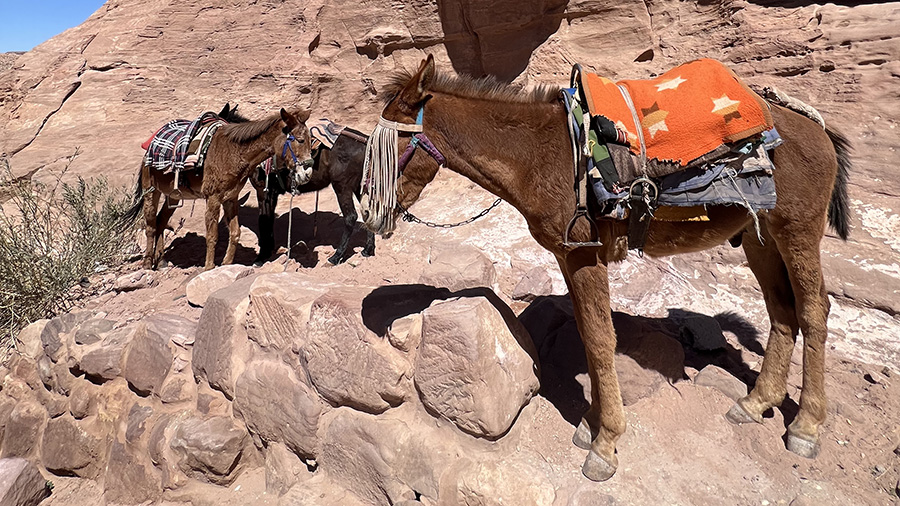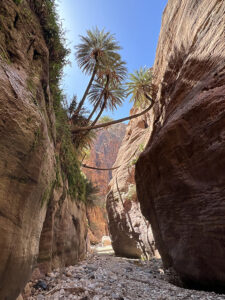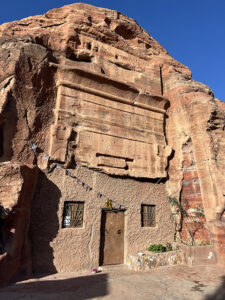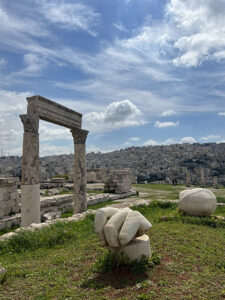
In Jordan, this family followed in the footsteps of Nabataeans, Romans and Moses, plus they made some trails of their own
By Jenny B. Davis
Photography by Coco Davis
Reclining against kilim-covered cushions under a glittering night sky, my family and I watched our Bedouin guide, Feras Alsamahin, fashion a game from rocks, sticks and a pattern he traced in the sand. It was hard to stay awake, but we wanted to see what came next.

Palm trees sprout from the walls in the Wadi Ghuweir river valley.
Our first day in the Wadi Araba desert of Jordan had been exhausting yet exhilarating. We’d spent hours roaring across the pitches and dips of the dunes in the back of Alsamahin’s truck, stopping at the higher slopes so we could sand sled to the bottom. Trudging our way back to the top again through the dense, warm sand was a challenge, but it was worth the effort to recapture the thrill of speeding down the surface of the sand.
When the sun began to set and the temperature began to drop, Alsamahin and his cousin Aiman set up our camp for the night. They treated us to a campfire-cooked chicken and vegetable dish and kettles of tea. After firing up their apres-dinner hookah, the men showed us how to play Tâb, a game of strategy and luck that’s been played by desert dwellers for over a thousand years.
For me, it was a fitful night of sleep. It would have been easy to blame the eight-hour time difference from Fort Worth or the din of the sand and wind swirling outside our tent. But I actually think I was just excited because the following day, we’d be heading to the cave.
The cave was the reason I reached out to Alsamahin’s tour company when we decided to visit Jordan. I knew we’d be heading to Petra during our 10-day trip, but the mid-rise hotels in the neighboring town of Wadi Musa that I was looking into seemed uninspiring. But a Bedouin cave? That’s where I wanted to be.
The tour company behind the cave is called Coulture Trips, a portmanteau of couture and culture. It’s owned by Alsamahin’s partner, a U.S. Army brat named Natalie Snider who trained as an archaeologist before specializing in bespoke, culture-immersive travel planning. She handles booking details and leads some of the tours, including small-group, women-only excursions to Jordan and Saudi Arabia. Alsamahin and his team handle the more general tours, the customized day trips and the private tours, like ours. The cave is also under Alsamahin’s purview. It’s been in his family for generations — he says it’s where he was born and lived as a child — and it’s one of many homes belonging to his extended family within the Petra Archeological Park.

Petra’s most recognized landmark, the Treasury, lies at the end of Al Siq, a sandstone gorge more than a half-mile long.
Petra, of course, is widely considered Jordan’s greatest tourist attraction. Both a new wonder of the world and a UNESCO World Heritage Site, the approximately 100-square-mile area is filled with temples and tombs, all carved into towering rose-colored sandstone cliffs. This was the former capital of a nomadic people known as the Nabataean, who settled the area sometime in the fourth century B.C. It became the center of their incense trade routes and where they lavished their wealth. At one time, up to 30,000 people lived here, trading with Egypt and India, carving awesome edifices and creating an elaborate water system that’s still visible today.
In the first century B.C., Petra became a client state of the Roman Empire, and it eventually lost its independence and importance thanks to the rise of sea trade and a catastrophic earthquake in 363 A.D. By the eighth century or so, the city was abandoned save for soldiers passing through during the Crusades and occasional nomadic occupants over the ensuing centuries. In 1812, a Swiss explorer happened upon Petra and brought the world’s attention to the ruined city. Today it’s overseen by a governmental agency dedicated to sustainably developing the area, conserving architectural treasures and managing the 1-million-plus tourists that visit its marquee attractions, including the Royal Tombs, the Monastery (possibly involving tombs) and the Treasury (also containing tombs).

This converted Bedouin family home was a Nabataean tomb.
Which led to my realization that Alsamahin’s cave isn’t really a cave at all. It’s a tomb. Alsamahin confirmed my suspicion with a shrug. At some point, he says, Bedouins happened upon the ruins, noticed all the room-shaped spaces carved into the hills like bureaus missing their drawers, and moved their families and livestock in. The Jordanian government relocated many of the Bedouins who used to live in this valley to the nearby town of Wadi Musa and village of Uum Sayhoun, but not everyone left. Alsamahin estimates there are still 45 or so families living throughout this valley, including Alsamahin’s parents and members of his extended family.
Snider and Alsamahin recognized the appeal of the cave, and they tricked it out for tourists, adding electricity and WiFi. (A full bathroom is located in an adjacent building steps from the cave.) Although the cave is no longer available for overnight accommodation, visitors are still welcome to enjoy lunch or tea alfresco while experiencing this extraordinary, authentic way of life, if just for a few hours.
Our first encounter with this ancient city was via Petra by Night, an interactive event with music, a multicolored light show and storytelling that was gimmicky yet still worthwhile. Following a day hiking through the Wadi Ghuweir river valley, where palm trees sprout from canyon walls, we washed up and headed to the Petra Visitors Center to redeem our tickets. This gathering of gift shops and eateries sits at the entrance to Al Siq, a sandstone gorge more than a half-mile long that serves as the primary portal to Petra and its most recognized landmark, the Treasury. Petra by Night, which runs every Monday, Wednesday and Thursday evening, offers an opportunity to experience the Treasury’s majestic facade illuminated by the soft glow of thousands of small lanterns. (The path through Al Siq is also lit only by lanterns, so those less sure-footed should plan to engage their smartphone flashlight.)
I wish I had a better recollection of that first night in the cave compound, but I slept as deeply as its original occupants. After a traditional Arabic breakfast of scrambled eggs, cheese, pita bread, tomatoes and sliced cucumbers, we mounted our donkeys and set out to explore the ruins. Because we were already technically in the park, we entered Petra through its back trail (yes, tickets still required), which led first to the Monastery.

Hospitality and great food are a given inside the Wadi Rum Caravan Camp.
Although it’s possible to walk, and many do, we were happy to be riding in our donkey convoy, led by Alsamahin on his horse — mostly because the long, steep trail includes a switchback-filled network of 800 or so irregularly shaped natural stone stairs. But our donkeys were pros, and soon we were, too, thanks to Alsamahin’s advice of leaning back for the ascent and forward for the descent (and holding the reins tightly at all times). Along the way, souvenir vendors lined the stairways, selling jewelry, magnets and such, and he helped us negotiate for several hand-embroidered scarves made by a local women’s craft collective, the Nabataean Ladies.
Entering the Treasury is prohibited, but nearly every other structure in the area is open to exploration, and we did just that. Leaving our mounts with Alsamahin, we spent the day trekking around the tombs and reading every informational plaque posted inside the ruins of the freestanding Roman temples and about the intricate mosaic floors of the Byzantine Church.
The next morning, Alsamahin took us out at dawn for a camel ride around his valley that included visiting some of the tombs that his friends and family had long ago converted into homes, along with the obligatory family-riding-camels pic. Then we set out on the approximately 90-minute drive to yet another extraordinary Jordanian must-see: Wadi Rum.
You may not know the name Wadi Rum, but you’ll recognize it immediately if you’ve seen any of the movies filmed there, including “The Martian,” two Star Wars movies and the two most recent “Dune” movies. (Indeed it was the movie “Lawrence of Arabia,” filmed here in the early 1960s, that kick-started tourism in Jordan.) The Wadi Rum Protected Area is both a UNESCO World Heritage Site and an epicenter of adventure — hiking, sandboarding, 4×4 tours and camel rides abound. We took a six-hour 4×4 tour to the most popular sites before heading to Wadi Rum Caravan Camp, a clean and extremely comfortable glamping-style campground. And because it was owned by Alsamahin’s relatives, hospitality and great food were a given.
While the desert destinations were memorable — my favorite was Khazali Canyon, where ancient petroglyphs are still visible on the rock walls — my most treasured memory was experiencing both the sunset (with a hearty grilled chicken dinner) and the sunrise (with a hearty Arabic breakfast) from the same outdoor bench and watching as the sand and stone seemed to turn a million different hues with every change of light. It was easy to imagine how many different people had experienced the same phenomenon over centuries, from Bedouins to Romans to Moses himself, who is believed to have passed through this area with the Israelites.
While this was the end of our time with Alsamahin and his team, it was just the beginning of the more metropolitan part of our adventure. We were heading to Jordan’s capital, Amman, a vibrant and multicultural city that’s much more colorful than its monochromatic architectural palette implies (let’s just say its nickname, “The White City,” is no surprise).
Considered one of the oldest continuously inhabited cities in the world, Amman was originally built across seven hills, but it now spans 19 hills and counts a population of over 4 million people. Lucky for us, these are a people who like to eat, and we happily (and hungrily) sampled some of the country’s most renowned recipes.
Mansaf was one we definitely couldn’t miss. Dating back a thousand years, this Bedouin braised lamb dish is a staple of all special occasions and is also the country’s national dish. We found ours at the Jameeda Khanum eatery and social club, where we ordered it with mint lemonade and also enjoyed live music. Mansaf is always served family-style — its name actually derives from the word for large tray — and there’s a special way to eat it. It’s best to have someone show you, but here’s a short, incomplete explanation of the ritual: using your right hand only, create a ball of meat and rice in your palm, then roll it into your mouth using three fingers or a flick of the thumb like you’re tossing a coin.

Arabic ice cream, dense and stretchy like marshmallow, is on display at Bekdash.
For dessert, we discovered another delicious ritual: the preparation of Arabic ice cream. One of the most popular places for this unique treat is Bekdash, a century-old ice cream parlor chain that originated in Syria, and part of its appeal has to be the show they put on for their customers. Arabic ice cream is similar to Western versions in that it’s sweet and served in a cone or a cup, but unlike ice cream, sorbet and gelato, this cold confection is dense and stretchy, like a frozen marshmallow.
The consistency comes from the thickener salep powder, derived from orchids, and from mastic gum, a type of tree resin, which adds the gum-like stretch. At Bekdash, its signature Arabic ice cream preparation process produces a lively percussion show for waiting customers as one server with a giant pestle smashes a slice of ice cream inside a tall metal cylinder in time with the other server, who’s dropping a beat with metal spatulas on a metal countertop. We also loved another dessert, a sweet cheese confection called knafeh. It comes in two versions, crispy or soft (we preferred the crispy), and we found our favorite at Habibah Sweets. Prepare for a wait, though — Habibah is everyone else’s favorite knafeh spot, too.
Although eating in Amman is top-notch (indeed Jordanian hospitality is legendary in the Levant and Middle East), the city is also renowned for its archeological sites. The Amman Citadel, a UNESCO World Heritage Site in the center of the city’s downtown, sits on one of the original hills and hosts a wide range of ruins including a Bronze Age wall, a Byzantine church, portions of a Roman temple and a palace dating to the Umayyad Caliphate. (If Roman ruins are your thing, be sure to head to the nearby city of Jerash to see some of the largest and best-preserved Roman sites in the world outside Italy.)

The Amman Citadel, a UNESCO World Heritage Site, offers expansive views of the city’s signature white buildings.
Our final adventure took us outside the city to spend an afternoon at the Dead Sea. This landlocked salt lake forms a border of Jordan and Israel; its name references the lack of sea life that can survive the extreme salinity. Lying nearly 450 meters below sea level, it’s the lowest land elevation on the planet and also the deepest hypersaline lake in the world.
While there’s no danger of encountering the sting of a jellyfish, anyone taking a dip should still exercise caution — the salt water stings if it gets into your eyes, a cut or even razor burn. But it’s definitely worth going in. The Dead Sea has been the site of health resorts for centuries, and it’s popular to slather your body with the mineral-rich mud and then head into the water to rinse it off. (Most resorts offer convenient mud-filled stations next to the water.) What impacted me more than the powers of the mud, however, was the information conveyed on the signs that lined the path from the resort’s changing rooms to the waterline. The signs were markers of where the water level used to be and when, making it easy to understand why its rapidly receding waters have created a crisis that will lead to cataclysmic ecological damage if left unchecked.
Walking into the water of the Dead Sea, it took a moment before I felt my limbs begin to rise. The high salt concentration creates a sort of super buoyancy, and even my head stayed supported when I relaxed into the water. Surrounded by the beauty of the land and warmed by the heat and light of the sun, I felt infused with a sense of peace. It was a feeling I hoped would last after I left Jordan, and one I wished everyone in the region could and would experience, today and always.
5 Things to Know Before You Go
While Jordan shares a border with Israel, the situation in Jordan when my family and I visited always felt safe. There was a visible military presence everywhere we went, and tourist police offices are centrally located at all major tourist destinations. If you’re concerned, however, you can find official information on foreign travel, including current travel advisories, online at travel.state.gov.
Consider purchasing a Jordan Pass before departure. The pass is good at over 40 attractions across the country, including Petra, Wadi Rum and the Citadel. You can buy it in-country, but purchasing it in advance allows you to bypass the $72 entry visa charge levied at the airport when you arrive.
While Jordan’s a thoroughly modern country where multiple religions live together in peace, it’s still a predominantly Muslim country, so it’s always best to leave the skimpy attire at home.
Renting a car is easy in Jordan, as is driving anywhere but in Amman. Traffic in this city makes Houston traffic seem tame.
For Dead Sea-goers, there are hotels at every price point along the coastline highway, and most offer day passes (often including a lunch buffet) for day-trippers. Public beaches exist, but they’re best left to the locals.
